
Awesome Athlete
She started playing tennis when she was just 7 and had no way of knowing then that the game would bring her fame, fortune, and most importantly, freedom. Travel back in time to center court at the 1981 U.S. Open, watch the moment she knew she could be authentically herself in her new country, and meet Martina Navratilova…
Her Ruby Shoe Moment
The Power of the Wand
Her Yellow Brick Road
Brains, Heart & Courage
Glinda’s Gallery
Just the Facts
Her Ruby Shoe Moment
Martina Navratilova took center court at New York City’s U.S. Open tennis tournament – one of the four major “Grand Slam” events in the tennis calendar. While Martina had enjoyed great success as a tennis player, she this was her ninth try to win the U.S. Open and her first appearance in the final match.
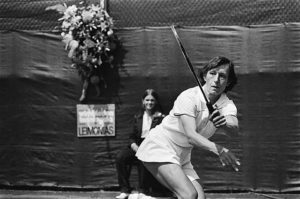
Martina in 1980.
On this September day in 1981, Martina was facing American born Tracy Austin. Martina had been living in the United States since she defected from Czechoslovakia to escape its authoritarian government when she was 18. Under asylum law, she had to wait at least 5 years before applying for U.S. citizenship. She had just been sworn in as a United States citizen 6 weeks earlier.
Martina was both proud and relieved to be appearing at the U.S. Open as an American citizenship. It was just a few years earlier, when she was 19, that Martina had made peace with the part of her that was romantically attracted to women. She had suppressed those feelings in Czechoslovakia, for fear of being labeled crazy and possibly institutionalized. Even in the United States, she worried that if she was publicly out, being too “controversial” could get her citizenship application rejected, so she chose to apply in California where attitudes were more accepting. During her interview with an immigration official, she was asked about her sexual orientation, answered truthfully, and watched carefully for the reaction. The official simply wrote her answer down and moved to the next question.
Feeling more confident that she could be herself in the United States, Martina gave an interview to a local reporter in Dallas, where she lived, and said she was bisexual. The reporter didn’t emphasize it in the news story and the information stayed local. She had also done an interview with a New York Daily reporter where she, believing she was off the record, had been honest with him about her fears of her relationship with her girlfriend going public. Before the Open, he called Martina and told her his said he was going to publish it because she was now famous. Martina worried about how her fans and the public would feel about her once they heard the news.
When Martina and Tracy took the court for the final match, Martina won the first set easily, 6-1. Tracy fought back and Martina started to fall apart, making several unforced errors. Tracy won the second set 7-6, and battled Martina to a 6-6 tie in the third set. In the tiebreaker, Tracy went up 5-1 to get to match point. It was Martina’s serve and she double faulted for the 13th time in the match, giving away game, set, match, and championship. Martina could feel tears welling up in her eyes. She fought the urge to run off the court.
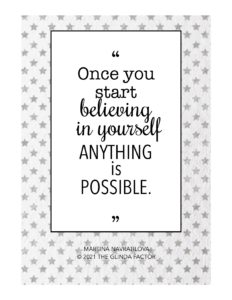 When the announcer called Martina’s name to present her runner up trophy, the crowd stood up and cheered for Martina and her efforts. They knew how much she had wanted this win and they showed their appreciation for the effort she had given. Her tears started to flow, and she caught them in her hands. “They were cheering for me as Martina, but they were also cheering for me as an American…I had never felt anything like it in my life: acceptance, respect, maybe even love…. This country was waiting for me. It would give me the friends and the space and the freedom and the courts and the sneakers and the weight machines…to play the best tennis any woman every played…”. “I didn’t feel like I belonged anywhere, until I came to America for the first time when I was sixteen.”
When the announcer called Martina’s name to present her runner up trophy, the crowd stood up and cheered for Martina and her efforts. They knew how much she had wanted this win and they showed their appreciation for the effort she had given. Her tears started to flow, and she caught them in her hands. “They were cheering for me as Martina, but they were also cheering for me as an American…I had never felt anything like it in my life: acceptance, respect, maybe even love…. This country was waiting for me. It would give me the friends and the space and the freedom and the courts and the sneakers and the weight machines…to play the best tennis any woman every played…”. “I didn’t feel like I belonged anywhere, until I came to America for the first time when I was sixteen.”
The Power of the Wand
Martina said it best: “sports are good for young women. It’s good to compete, good to run, good to sweat, good to get dirty, good to feel tired and healthy and refreshed.” Her style of aggressive tennis, fair play, and emphasis on muscular and cardiovascular strength and good nutrition had a long lasting impact on the world of tennis. There are some amazing teenage players following in her footsteps, including 17 year old Coco Gauff and 19 year old Amanda Anisimova, whose parents immigrated to the United States from Russia before she was born.
Her Yellow Brick Road
When Martina was 16, the Czech Tennis Federation was interested in the glory and prize money Martina could bring them from big tennis tournaments, and sent her to United States to play there for two months. The government gave her plane tickets, $11/day for food, and a chaperone. The American fans cheered Martina’s exciting style of serve and volley tennis, and appreciated her sense of fair play. She would correct bad calls, even if it meant losing the point. Her English quickly improved and she developed a love for American junk food.
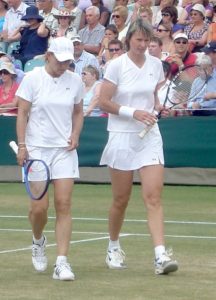
Martina with Helena Sukova at Wimbledon in 2009
Martina returned to the United States a year later, and Tennis Magazine featured her as its 1974 Rookie of the Year. All of her prize money went to the Federation. Martina ate the free food offered to players between matches so she could save her daily meal stipends for her family, saving enough to buy them a car.
Martina’s success made everyone at home nervous. Her parents wanted her to stop traveling and get her high school diploma. The Tennis Federation feared she liked the United States too much and reminded her that her ability to travel depended on their good will. But since Martina brought the government desired money and recognition, they let her spend much of 1975 abroad. Martina began winning and earning more, and decided to use that as leverage for more freedom. She hired an American agent who negotiated a deal with the Federation that allowed her to keep 80% of her winnings.
When Martina returned home, the threats to her freedom resumed. The government told Martina to behave, act less American, and remember that since they made her, they could break her. This put Martina in a terrible position. If she wanted to be free to make her own choices, she would have to escape. But if she left, she might never see her family again. After Wimbledon that year, she was called before the Czech Sports Ministry where they asked if she was planning to defect. She said no.
The U.S. Open in New York was the next big tournament on the calendar. The Tennis Federation, again tempted by the glory and prize money, gave Martina permission to play on the condition that she return home immediately after the tournament ended. Martina knew this may be her last chance for freedom, and said goodbye to her family not knowing when she would see them again.
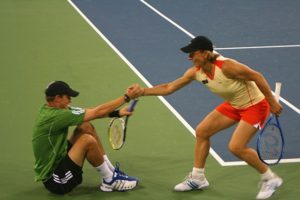
Martina helping her mixed doubles partner at the U.S. Open in 2006
Once in New York, Martina decided to apply for asylum. It became a huge news story, and Martina had to hide at a friend’s apartment for fear that the Czech government would kidnap her and force her back. Martina received permanent resident status, which allowed her to live and work in the United States. It would be five years until she could apply to be a citizen. This meant avoiding airplanes with routes over eastern Europe, because in an emergency landing, she could be removed from the plane and arrested.
Martina struggled personally after defecting. She missed her family and worried they would be mistreated. The Czech government first shamed her in its national press by claiming she chose money over patriotism, and then banned mention of her name. She had a hard time controlling her emotions on and off the court. She yelled “Stupid!” at herself when she made a mistake and didn’t win a tournament for 11 months. When she lost in the opening round of the U.S. Open to newcomer, she sat down on the court and cried. She remembers, “I was confused. I started doubting myself on everything.”
Martina needed help and found it with a new friend and coach named Sandra Haynie, a champion golfer who taught Martina about the importance of eating healthy and focusing on one point at a time. Things turned around and Martina achieved her childhood dream of winning Wimbledon in 1978.
She was ranked #1 in the world and the Czech government, wanting some of that reflected glory, gave her family permission to travel to Wimbledon the following year. It was the first time she had seen them in four years, and they got to see her repeat her victory. They defected to United States to live near Martina a few months later, but had a difficult time adjusting to the culture and soon returned to Czechoslovakia.
Martina reverted back to her unhealthy habits and her tennis suffered. She was only 24 and didn’t want to retire, so instead recommitted herself to a healthy lifestyle. Again, she found people who became coaches and friends who helped her with training, strategy, and morale.
Brains, Heart & Courage
Martina grew up in a Czechoslovakia that was controlled by the Communist Party. It was part of a group of countries under the influence of the Soviet Union called the Iron Curtain. The Party owned and distributed all property and strictly controlled citizens’ ability to work and travel. Sports were used to build national pride and distract people from their lack of freedom. The Soviets assigned each Iron Curtain country a sport in which to excel. Czechoslovakia got tennis, and the Party established a Czech Tennis Federation that had a lot of power.

Martina in Czechoslovokia
Martina spent her early years in the Krkonose Mountains. Her mom, Jana, was a ski instructor and natural athlete. Her dad, Miroslav Subert, worked with the ski patrol. When she was 3, her parents divorced and Martina and her mom moved to Jana’s childhood family home, which the government had converted into apartments. She rarely saw her biological father, who committed suicide when she was 9.
Martina loved sports. There were few indoor facilities, so her favorite depended on the season. In winter, she played hockey. In summer, she and her mom played tennis at the public courts. There they met Mirek Navratil, one of the best tennis players in town. Mirek and Jana got married when Martina was 6, and he moved into their one room apartment.
Martina spent hours hitting tennis balls against the wall while her parents played. Her Wimbledon dreams started when she was 7 and saw it for the first time on television. Mirek started giving her formal lessons and would have her pretend she was playing there. Mirek was a good teacher: he encouraged her natural instinct to play aggressively and reminded her that she should simply enjoy the game.
When Martina was 9, Mirek brought her to Prague try out for famous coach George Parma. Martina took the court with her secondhand wooden racket clutched in her left hand. After hitting with her, George agreed to provide weekly lessons. It was a commitment: Martina took the train 16 miles to Prague, transferred to a streetcar, and walked the rest of the way. She trained with George until 1968, when the Soviets invaded Czechoslovakia to stop the growing dissent there. Martina was 11 when tanks rolled into town and soldiers took over the streets. George was in Austria at the time and never returned.
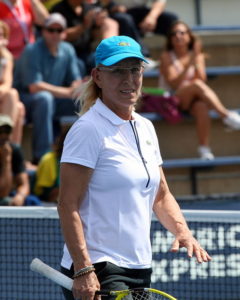 Tennis gave Martina confidence. She was self-conscious about her appearance, but that didn’t matter on the court. Neither did her outspoken nature, which made her outsider in school because people with opinions could get into trouble with the government. It also gave her an opportunity to travel more than most, and visit the places she had learned about her in favorite class, geography. Her family, which now included little sister Jana, had no hot water and no car, but would save all winter to pay for Martina’s travel and equipment.
Tennis gave Martina confidence. She was self-conscious about her appearance, but that didn’t matter on the court. Neither did her outspoken nature, which made her outsider in school because people with opinions could get into trouble with the government. It also gave her an opportunity to travel more than most, and visit the places she had learned about her in favorite class, geography. Her family, which now included little sister Jana, had no hot water and no car, but would save all winter to pay for Martina’s travel and equipment.
After the invasion, Martina watched as her country lost its optimism about its future. When Martina was 12, she traveled to a tournament in West Germany. She was the youngest player on the Czech team and it was her first trip outside the Iron Curtain. She immediately observed how much more open society was. People could express their opinions without fear, and it seemed that everyone had a car and a television. She was excited to find felt tip pens in a store – a rarety in Czechoslovakia – and brought them home for her sister and friends.
A few years later, the Tennis Federation invited Martina to join the best tennis club in the country, the Sparta Sports Club in Prague. She won an age group national title that same year, and the newspapers wrote she was the “tennis star of the future.” This made her very valuable to the government, and they pressured her to join the Communist Party and encourage other young people to join.
Glinda’s Gallery
Just the Facts
- iMartina was born on October 18, 1956. Her parents named her after Martin’s Place (Martinovka), the ski lodge they lived in when she was born.
- After her mother remarried, Martina took her stepfather’s last name and became Martina Navratilova. In Czech tradition, girls and women use “ova” at the end of their last name.
- Martina’s serve was clocked at 90 miles per hour.
- During their 1978 Wimbledon final, longtime friend and rival Chris Evert hit Martina in head with ball and knocked her down. When Martina won, Chris met her at the net, rubbed Martina’s head and said “I hit you in the head and you started playing better!”
- Martina won 15 of 18 tournaments in 1982 before she started struggling with illness and fatigue. She fought through it and won 16 of 17 tournaments and 86 of 87 matches in 1983. She finally achieved her goal of winning the U.S. Open by beating Chris Evert, who patted Martina on the back as they walked off the court.
- Martina credited her training, including running and lifting weights, to her success and encouraged other women players to do the same and think of big muscles and power as “unfeminine”
- Martina had two record-setting winning streaks broken by younger Czech players. After winning 54 matches in a row, she lost to Hana Mandlikova, who had been her ball girl in Prague. Martina regrouped, developed a wider range of shots, and started another winning streak that would last 74 matches until she lost to Helena Sukova in the finals of the Australian Open.
- Martina founded the Martina Youth Foundation, which funds rackets, balls, court time and tennis lessons for kids who couldn’t otherwise afford to play. Martina gives lessons on inner-city courts around the country.
- At age 27, Martina won the “Grand Slam” – four majors in a row. She was the fifth player to do so. She was the first player to win all four in a calendar year in 1994, earning a $1 million prize from the International Tennis Federation.
- In her career, Martina won 18 Grand Slam Singles Titles and 31 Grand Slam Doubles Titles.
- Martina has written several books, including Tennis My Way, which teaches strokes, tactics, skills drills, weights, workouts, nutrition and motivation.
- Donna Lopiano, executive director of the Women’s Sports Foundation, said that “Martina was the first legitimate superstar who literally came out while she was a superstar. She exploded the barrier by putting it on the table. She basically said this part of my life doesn’t have anything to do with me as a tennis player. Judge me for who I am.” She lost millions of dollars in endorsements.
- Martina had a roller coaster relationship with fans. Some didn’t like her strong emotions on the court and outspoken nature. Others would root against her because she was out.
- Martina has been married to Julia Lemigova since 2014 and has two stepdaughters.
Want to Know More?
Leder, Jane Mersky, Martina Navratilova (Crestwood House 1985)
Knudson, R.R. Martina Navratilova: Tennis Power (Viking Kestrel 1986)
